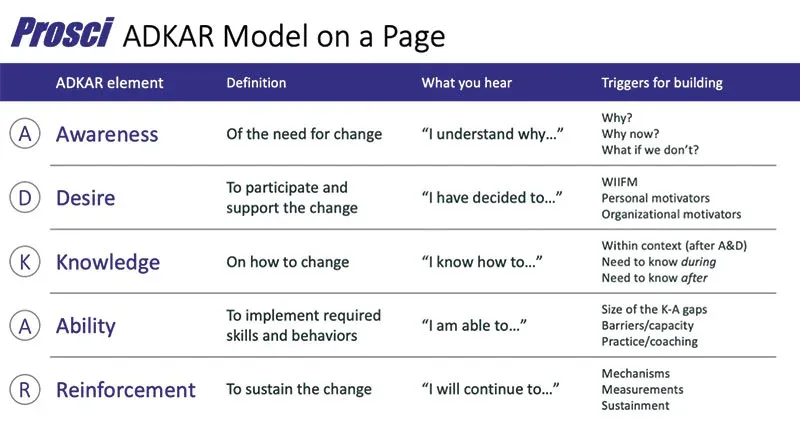In the fast-paced landscape of today's business world, organizations continually face the need for change to remain competitive, adapt to market shifts, and innovate. However, implementing change within an organization is no small feat. More often than not, change initiatives fall short of their intended outcomes, leaving leaders scratching their heads and employees feeling disengaged or resistant.
One powerful framework that addresses this challenge is the ADKAR model. Developed by Prosci in 2006, a leading change management research firm, the ADKAR model provides a structured approach to understanding and managing individual change within an organizational context.
What is the ADKAR Model?
ADKAR stands for Awareness, Desire, Knowledge, Ability, and Reinforcement. It represents the five key milestones that individuals must achieve for successful change adoption:
- Awareness: This stage involves ensuring that individuals understand why the change is necessary and what it means for them personally and for the organization as a whole.
- Desire: Once individuals are aware of the change, they need to develop a desire or motivation to support it. This stage focuses on addressing concerns, highlighting benefits, and fostering a positive attitude towards the change.
- Knowledge: With awareness and desire in place, individuals require the knowledge and skills to implement the change effectively. This stage involves providing training, resources, and support to enable individuals to perform their new roles or tasks.
- Ability: Knowledge alone is not enough. Individuals must have the ability to apply what they have learned in their day-to-day activities. This stage focuses on providing opportunities for practice, mentoring, coaching, feedback, and continuous improvement.
- Reinforcement: Change is an ongoing process, and sustaining it requires reinforcement mechanisms. This stage involves recognizing and rewarding desired behaviors, adjusting systems and processes to support the change, and addressing any remaining resistance or barriers.

Why Does Organization Change Often Fail Without Engaging Individuals?
Organizational change initiatives often fail because they neglect the human element. Even the most well-thought-out strategies and plans can falter if individuals within the organization are not adequately engaged in the change process. Here are some reasons why:
- Resistance: Without effective communication and involvement, individuals may resist change due to fear of the unknown, concerns about job security, or skepticism about the benefits of the change.
- Lack of Understanding: When individuals don't understand the rationale behind the change or how it will affect them personally, they may feel disconnected and disengaged, leading to apathy or resistance.
- Skill Gaps: Change often requires new skills or ways of working. If individuals are not provided with the necessary training and support to develop these skills, they may struggle to adapt and perform effectively in their new roles.
- Lack of Ownership: For change to be successful, individuals need to feel a sense of ownership and accountability. If they are not actively involved in the change process or given the opportunity to contribute their ideas and feedback, they may not fully commit to the change.
- Poor Communication: Effective communication between the leadership and the teams is essential for building awareness, addressing concerns, and maintaining momentum throughout the change process. Without clear and consistent communication, rumors, misinformation, and uncertainty can undermine the change effort.
Successful change requires ongoing reinforcement to sustain the momentum and embed new behaviors into the organizational culture. This involves celebrating milestones, recognizing achievements, and continuously communicating the benefits of change. By reinforcing desired behaviors and outcomes, organizations can prevent the regression to old habits and ensure that the change becomes ingrained in the fabric of the organization.
The ADKAR model provides a comprehensive framework for organizations to navigate the complexities of change by focusing on the individuals at the heart of the organization. By cultivating awareness, desire, knowledge, ability, and reinforcement among employees, organizations can increase the likelihood of successful change initiatives and drive sustainable results. Remember, change is not just about implementing new processes or technologies—it's about engaging people on a personal level and empowering them to embrace and thrive in a constantly evolving world.

